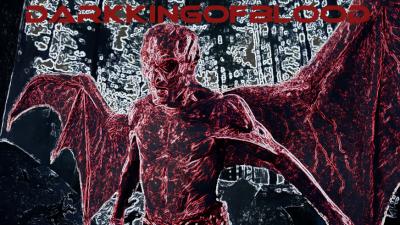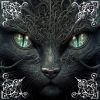
Origin Of The Word "Vampire"
Most etymologists (persons who study the origins of words)
agree that "vampire" is from the Slavic "vampir" or "vampyr"
and first appeared in the 1600s in the area of what is now
Bulgaria and Yugoslavia on the Balkan peninsula. However,
attempts to trace back the origin of the Slavic "vampir" are
still under dispute. The theory currently favored is that "vampir"
came from "upir", which first appeared in print in a 1047 CE East
Slavic (Old Russian) manuscript in which a Novrogordian prince
is referred to as "Upir Lichy" (Wicked Vampire). Tracing the
source of "upir" and its Slavic cognates (i.e., upior, obyrbi,
upirbi, obiri) is even more controversial, fraught with many
theories but little documented evidence.
For example, Franz Miklosich, a late 19th century linguist,
suggested that "upir" is derived from "uber", a Turkish word for
"witch". Andre Vaillant suggests just the opposite--that the
Northern Turkish word "uber" is derived from the Slavic "upir".
More recently, Jan Perkowski, who has done a great deal of
research on the vampires of the Slavs, also favors a Slavic origin
to the word.
But even amongst those who lean towards a Slavic origin,
there is considerable disagreement. Kazimierz Moszynski
suggests that "u-pir" is from a Serbo-Croatian word "pirati" (to
blow). Aleksandr Afanas'ev points to the Slavic "pij" (to drink),
which may have entered the Slavic language from the Greek, via
Old Church Slavonic. A. Bruckner proposes Russian "netopyr"
(bat).
These are just a few of the possible origins of the
word "vampire." For now, it appears that the best answer to
the question of where the word originated is that it's a Slavic
word. But where the Slavs got it is still an unanswered
question.


Definition Of Vampire
There is no mutually-agreed upon newsgroup definition
for "vampire." Ask a dozen readers, and you're likely to get a
dozen different answers. However, a workable blanket
definition for the various types of vampires from legend and
fiction might go something like this: A vampire is a being
who, in order to maintain its existence, must feed on the
vitality of humans. Given that core definition, you're now free
to qualify the terms to suit the specific type of vampire being
described.
For example, the vampire
can be living, dead, undead, or spiritual. "Vitality" can mean
blood, lifeforce, passion, chi, soul, psychic/sexual energy, etc.
Important to the definition is the word "must" in that it
disqualifies blood fetishers who do not NEED blood to survive.
"Feed" can be changed to "ingest", "suck", "prey" or "drink"
but, whatever term is selected, it should disqualify flesh-eating
beings such as ghouls.
Surveyed readers of a.v. rated 16 characteristics as to their
perceived importance to the definition of "vampire." The
most important features of a "vampire," according to the
150+ replies received, are that s/he feedson human lifeforce,
does not age, is immortal, and drinks human blood. This
gives more weight to the suggested blanket definition in
which the vampire is a being who must feed on the
vitality of humans in order to survive, with the added
qualifiers that, if the need is met, the vampire is rendered
unaging and long-lived.
[NOTE]: The term "long-lived" is currently preferred over
"immortal" because immortality implies that one cannot cease to
exist, yet there are a number of ways that vampires can be
destroyed.
Of medium importance are that the vampire is a living
corpse, is telepathic, is harmed by the sun, feeds on human
passions, and has fangs. Of little importance is that s/he
casts no reflection, loves darkness, has a pale complexion,
sleeps in a coffin, is repelled by a cross, is prone to
obsessive love, and wears a black cape.



Types of Vampires in Existance (legends)
- Asasabonsam: W. African. Folklore of the Ashanti people. Asasabonsamare human looking vampires except that they have hooks instead of feet and iron teeth. The Asasabonsam are tree dwelling vampires that live deep in the forest. They sit in the tops of trees with their legs dangling down which enables them to catch their victims with their hooked feet. They tend to bite their victims on the thumb.
- Baital: Indian. These vampires natural form is that of a half-man, half-bat creature roughly four feet tall. They are otherwise unremarkable.
- Bajang: Malaysian. The bajang normally take the form of polecats. Sorcerers could enslave and force them to kill his enemies, and some families were believed to be hereditarily stalked by the bajang.
- Baobhan Sith: Scottish. The baobhan sith (pronounced buh-van she) are evil fairies who appear as beautiful young women and will dance with men they find until the men are exhausted and then feed on them. The baobhan sith can be harmed and destroyed by cold iron.
- Callicantzaros (also spelled as Kallikantzaros): Medieval and Modern Greece. According to Christian Greek folk belief, a child born during the time from the beginning of Christmas to New Year's Day (or, in some versions, to Epiphany, Jan. 6) will become a callicantzaros. It is also during this period of the year that the callicantzaroi become a threat to normal humans. Then they roam the countryside, sleeping in
caves during the day and entering villages at night. They can appear half-human, half-animal shapes. At the end of this period, they travel down caverns or other tunnels to Hades where they remain until the next Christmas. While on the world's surface, a male Callicantzaros is apt to kidnap a mortal woman to return with him to the underworld as
his bride and to bear his children who also become callicantzaroi. To prevent an infant of two mortal parents born during the Yuletide season from becoming a callicantzaros, the infant was sometimes held feet down over a fire until the toenails were singed. It was said that the first victims of a callicantzaros whose parents were both mortal were often his own brothers and sisters, whom he was apt to bite and devour. The callicantzoroi are actually closer to werewolves than to vampires--there is no direct connection with blood drinking--but they are frequently described in nonfictional books about vampires.
(s/b Patrick Johnson)
- Ch'ing Shih: Chinese. Ch'ing shih appear livid and may kill with poisonous breath in addition to draining blood. If a Ch'ing Shih encounters a pile of rice, it must count the grains before it can pass the pile. They can be harmed and destroyed by normal weapons and by sunlight. Their immaterial form is a glowing sphere of light, much
like a will-o'-the-wisp.
- Civateteo: Mexican. These vampire-witches held Sabbaths at crossroads and were believed to attack young children and to mate with human men, producing children who were also vampires. They were believed to be linked to the god Tezcatlipoca.
- Dearg-due: Irish. The dearg-due is a standard European vampire, except that it cannot shapeshift and may be defeated by building a cairn of stones over its grave.
- Empusa: Ancient Greece and Rome. Empusas appear as either beautiful women or ancient hags. They are strongly related to the incubi and succubi (q.v).
- Ekimmu: Assyrian. Montague Summers described the ekimmu as vampires, but recent re-interpretations of "The Gilgamesh Epic" seem to refute this conclusion. The ekimmu are simply the souls of those who died without proper burial and so they wander the Netherworld looking for
peace, not blood.
- Hanh Saburo: Indian. These creatures live in forests and can control dogs. They will attempt to lure or drive travelers into the forest to attack them.
- Incubus: European. Incubi (plural of incubus) are sexual vampires. They are spirit vampires of a demonic nature. The general way they feed is by having sexual relations with the victim, exhausting them, and feeding on the energy released during sex. They may enter homes uninvited and can take on the appearance of other persons. They will often visit the same victim repeatedly. A victim of an incubus will experience the visits as dreams. The female version of an incubus is a succubus. Closely related to the incubi/sucubi are the Slavic mora, the German mahr, and the Scandinavian mara, from which the word "nightmare" is derived.
- Jararaca: Brazilian. Normally appearing as snakes, jararaca are said to drink the milk, as well as the blood, of sleeping women.
- Krvopijac: Bulgarian. Krvopijacs (also known as obours) look like normal vampires except that they have only one nostril. They can be immobilized by placing wild roses around their graves. One way to destroy a krvopijac is for a magician to order its spirit into a bottle, which must then be thrown into a fire.
- Lamia: Ancient Greece and Rome. Lamias are exclusively female vampires. They often appear in half-human, half-animal forms and eat the flesh of their victims in addition to drinking their blood. Lamias can be attacked and killed with normal weapons.
- Loogaro: West Indies. Appearing as old women, these vampires go abroad at night as blobs of light, much like the will-o'-the-wisp.


- Mulo: Gypsy. Gypsies all over Europe generally believed that the mulo was the spirit of a dead person which left its corpse in its grave at night and returned to the corpse at dawn. The mulo was generally invisible but could be visible to certain people, in which case it usually appeared in the original form of the dead person.
Some Gypsy clans believed that their muli were too loyal to their clan to trouble them. But in the cases of clans who believed otherwise, esp. in Balkan countries such as Kosova, Serbia, Montenegro and Bosnia, the mulo often played the role of the vampire. The vampiric mulo mostly preyed on sheep and cattle, but there are tales of entire households being victimized by a mulo. In the Balkan countries, the adult male mulo typically came at night to visit his widow or perhaps a woman he had loved during his lifetime. In some versions of the story, he acted kindly towards her, helping her with household tasks and regaining her favor. Or, he might make demands on her for good tasting food, always rejecting what she offered. While visible to his wife, he might at the same time be invisible to other family members, behaving much like a poltergeist. In a third version, the mulo is invisible even to his wife, but he lies upon her and rapes her while she feels paralyzed and is unable to cry out for help. In these chases, the widow may become sick with terror, refuse food and drink, and eventually die.
Some Gypsies in Kosova believed that twin brothers and sisters born on a Saturday could see a vampiric mulo if they wore their underwear and shirts inside out. The mulo would flee as soon as it was seen by the twins. A Gypsy practice in Moravia, now the eastern province of the Czech Republic, was to use a hen's egg to bait and ambush an invisible mulo. When the egg suddenly disappeared, the men would fire their guns at the spot. (s/b Patrick Johnson)
- Nachzerer: German. These are ghosts of the recently dead that return to kill their families.
- Rakshasa: Indian. The Rakshasas are powerful vampires of the spirit variety. They usually appear as humans with animal features (claws, fangs, slitted eyes, etc.) or as animals with human features (flattened noses, hands, etc.). They often appear as tigers. In any form, rakshasas are powerful magicians. They eat the flesh of their victims in addition to drinking blood. Burning, sunlight, or exorcism may destroy Rakshasas.
- Shtriga: Medieval and Modern Albanian. The Albanian Shtriga, like the ancient Roman Stryx, is a witch who preys upon infants by drinking their blood at night. But instead of transforming into an owl when she goes for her midnight snack, she is more apt to take the form of a flying insect. As recently as the early 20th century, many Albanians regarded the Shtriga to be the most common cause of infant deaths.(See also Veshtitza.) (s/b Patrick Johnson)
- Strigoi: Medieval and Modern Romania, including Transylvania. The feminine form of the name is Strigoiaca. The terms derive from the name of the blood-sucking, shape-changing, ancient Roman 'Stryx' [which see]. They apply to either a person who is already an undead vampire (Strigoi Mort) or to one who is still living (Strigoi Viu) but predestined to become a Strigoi Mort. In most ways, the Strigoi Morti resemble the undead vampires found in other Eastern European countries. They can be destroyed by such typical means as impaling with a stake or by cremating them. They were often blamed as the cause of death in cases of epidemics --with the dead victims frequently becoming Strigoi Morti, too.
The Strigoi Vii are more unusual. According to old Romanian folklore, a person who is born with a caul (a veil of fetal membrane still attached to the head), a small tail, or other peculiar circumstances is a Strigoi Viu. While living, the Strigoi Viu is not a blood drinker, but his powers include what could be called psychic vampirism--he can steal the vitality of his neighbors' crops and animals to enhance his own. Also, he can leave his body at night and travel in the form of an animal or a small spark of light. Sometimes it was said that a Strigoi Viu took animal form by stealing the form from the animal. The Strigoi Vii join together in covens and meet with the Strigoi Morti on special nights such as the Eve of St. George (April 22)--the same auspicious night when Jonathan Harker meets Dracula in Bram Stoker's novel. (s/b Patrick Johnson)
- Stryx: Ancient Roman. Stryx [plur: striges] literally means "screech owl" but the ancient Romans also applied the term to witches who transformed into owls at night in order to prey upon infants, drinking their blood and sometimes eating their internal organs. In modern Italian, "striga" has become a general word for "witch". Ovid, in his book _Fasti_, tells a story about an infant who was attacked each night by a flock of striges. The demigoddess Crane is called upon to ward away the striges by sprinklng the doorway with "drugged" water and placing a branch of hawthorn in the window. In later European lore, hawthorn is often as effective as garlic for warding away or confining vampires and is the best material for stakes to pound through their hearts. [See also Shtriga, Strigoi, and Veshtitza] (s/b Patrick Johnson)
- Vampir: Serbian. The vampir is naturally invisible but can be seen by animals or by a dhampir [q.v], the living offspring of a vampir. The Serbian vampir cannot shapeshift.
- Veshtitza: Medieval and modern Montenegro and Serbia. A blood drinking witch similar to the Roman Stryx and the Albanian Shtriga.
The soul of a Veshtitza leaves her body at night and enters the body of a hen or black moth. In this body, the veshtitza flies about until she finds a home where there are infants or young children. She drinks their blood and eats their hearts. Veshtitze may join together to form covens, the members of which flock together in the branches of trees at midnight on certain nights to hold a meeting while they snack upon what they have gathered earlier. Since it was commonly believed that witches become vampires after they die, it seems unlikely that the natural death of a veshtitza ends her drinking habit. (s/b Patrick Johnson)
- Vrykolakas: 17th - early 20th Century Greece. The term derives from the Southern Slavic name Vorkudlak which can either mean an undead vampire or a werewolf. The name Vrykolakas (plur: Vrykolakes) has variants such as Vourkalakas and Vrukolakas. On the isle of Crete, the name is often replaced by 'Kathakano". In some moutain regions on the mainland, the term Vrykolakis could also apply to a shepherd who is compelled by the full moon to go about biting and eating both man and beast. But most generally it was applied to dead people who return from their graves, bringing death to the living. When a dead person was suspected of being a Vrykolakas, his corpse was exhumed to see if it had resisted decay. Also, there was a religious practice of exhuming all corpses after three years from their original burial. Typically, an exhumed corpse appeared bloated and ruddy. This was interpreted as evidence that the body had become a Vrykolakas and had gorged itself on the blood of its victims.
A person could become a Vrykolakas after death by having been excommunicated, by having committed a serious crime or by having led a sinful life. Those conceived or born on a holy day were predestined to become Vrykolakes. Even if a person died without these taints, he was apt to become a Vrykolakas if a cat jumped over his corpse before burial. Though Vrykolakes were most active at night, they could also go about during daylight. They were only obliged to be in their graves on each Saturday. According to one report from the 17th century, revenant Vrykolakes prowl at night, knocking on doors and calling out the names of the inhabitants. Anyone who answered was doomed, but those who resisted were spared. Perhaps this is the origin of the modern literary tradition that a vampire cannot enter a home unless invited? Vrykolakes can be destroyed by exorcism or burning. Yet another recourse was to rebury the corpse on a desert island. This was done in belief that a Vrykolakas could not cross sea water (s/b Patrick Johnson)
- Wampir: Polish and Russian. Wampiri appear exactly as normal humans and have a "sting" under their tongue rather than fangs. They are active from noon until midnight. A vampir may only be destroyed by burning. When burned, the wampir's body will burst, releasing hundreds of small, disgusting maggots, rats, etc. If any of these escape, the wampir's "spirit" will escape as well and will later return to seek revenge. Wampiri may also be called vieszcy and upierczi.
Of course, this list is not exhaustive. Some other regional variants on the vampire are: Austrian dracul, Amer. Indian kwakiytl, Bohemian ogolgen, Brazilian lobishomen, African otgiruru, African owenga, Romanian avarcolac, Babylonian sharabisu, Greek brucolacas, Tibetan khadro, Singhalese kattakhanes, and Hindu kalika.

Powers Most Common For A Vampire
There are many different versions of the vampire myth, both in legend and in fiction, therefore any ability you could name has probably been been ascribed to vampires at some point. Here are some of the powers traditionally ascribed to European vampires (the kind most often portrayed in movies and literature)...
- Ability to change shape. Common animate forms assumed are: wolf, bat, rat, cat, owl, fox, weasel, raven, spider, scorpion, moth and fly. Inanimate objects which might also be assumed are mist, orbs of light, even a ball of dust like you find under your bed [ ch'ing shih, loogaroo ]. In some myths, the vampire's true form is inhuman, and they shapechange into humans [ lamia, baital, bejang, jaracara, rakshasas ].
- Strength, speed and sensory perception far greater than that of humans.
- Ability to summon and control animals, particularly rats and wolves.
- Mind-control...may command mortals, strike fear with a look, or cause selective amnesia.
- Ability to control the weather...summoning rain clouds and fog.
- Ability to command some form of magical or mystical beings, with the implicit idea that the vampyre is in league with an evil entity.

Stamp

*If u add me as a friend plz tell me so i can return the add*


























